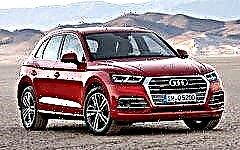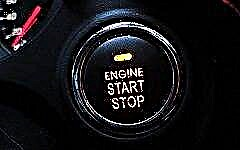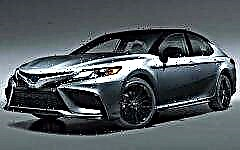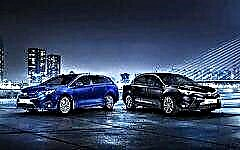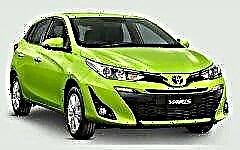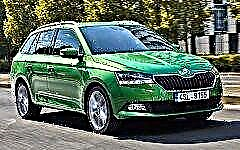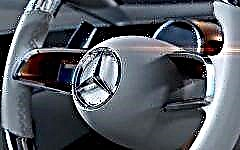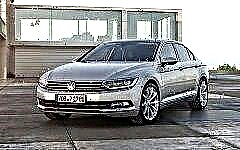

The content of the article:
- Generations of the Passat
The name of the car was born by the fantasy of Volkswagen with an international scope. The trade wind is common in all corners of the earth, and automakers are forced to maintain the level of sales, making a change in the appearance of the model every five years.
In just 46 years since its creation, Passat has managed to release 8 generations of the car, which is popular on different continents. He is especially honored in America, Asia, Europe and China.
Generations of the Passat
B1. 1st generation (1973-1988)

In the photo: 1st generation Volkswagen Passat
The car, named Passat, was built on the B1 platform in 1973. For its time, it looked modern and technologically advanced. His capabilities were evaluated a year later, when he won the title of "Car of the Year".
The first Passat was based on the Audi 80, which was previously recognized as the best car of the year in Europe. The Volkswagen company had acquired Audi ten years earlier, so it took full advantage of the workings of Horch's brainchild.
The transmission of that time seems primitive - “mechanics” with four steps and a three-speed automatic transmission. The car was produced with front-wheel drive. The body was available in three-door hatchback and five-door station wagon variants.
The range of power units has gradually increased, offering a choice (in liters):
- 1,3;
- 1,5;
- 1,6;
- 1.5 on diesel fuel;
- injection GLI.
The last "German" version of the assembly of this generation in Europe was completed in 1980. For eight years, more than 2,600,000 copies of the car were produced.
At the Brazilian factories, the first generation of Passat lasted much longer - the car, loved by people, was produced until 1988.
B2. 2nd generation (1981-1988)

In the photo: 2nd generation Volkswagen Passat
In order to be at the peak of sales all the time, it is necessary to keep the attention of consumers by releasing models that differ from the previous version at least slightly in the direction of improving either the technical filling or by reducing the price.
Having modernized the first generation, the Passat has perked up at the expense of a new body - a sedan, having received a new name - Santana. Following the tendencies of the world automata, the car has acquired sharper, square shapes. All roundness in lines, lanterns and headlights is gone, transforming into squares and rectangles.
The size of the car also became larger, which for the better affected the size of the cabin and trunk.
Continuing to improve the Passat, new modifications of the second generation entered the market. The Passat E was equipped with electric window lifters, and the Passat Variant was offered to customers in a station wagon. Manufactured in Japan, it was assembled at Nissan factories, sold in the Land of the Rising Sun under the Japanese label.
The engine lineup is complemented by a brand new 2.2-liter five-cylinder engine capable of developing 115 hp. All other engines remained quieter, not exceeding 75 hp. with.
The improved Passat became available not only with a three-speed automatic transmission, but also in an all-wheel drive version. In Europe, the model was a success, the second generation cars were driven on the roads of the Old World at least 3,000,000.
In 1987, the company decided to complete the B2 release. In Brazil, the car was successfully sold, leaving the assembly line until 2006.
In China, the second generation Passat is still being produced - the car meets all the necessary needs of the inhabitants of the Middle Kingdom and is quite budgetary with very good quality.
This model was assembled in the territory of Mexico, as well as Argentina and South Africa, earning international popularity.
B3. 3rd generation (1988-1993)

In the photo: 3rd generation Volkswagen Passat
Obeying the trends of business competition in the market, the third generation Passat was designed on a platform that was completely non-standard for the model, with the engine positioned sideways.
The "face" of the car did not have a radiator grille, which could not but attract the interested glances of potential buyers who wanted something "different from others." Versions in station wagon and sedan bodies were available for purchase, they were distinguished by the degree of coolness by letter markings:
- CL - sedan of the basic version;
- GL - deluxe version;
- GT - a version above the luxury level, but not reaching the "full stuffing";
- GLX is the coolest and coolest version.
Gearboxes have also changed - now the "mechanics" involved in the movement of five steps, and the "automatic" worked in a four-band mode.
All cars to choose from were offered with engines from 1.6 liters to 2 liters, capable of delivering power in the range from 72 to 136 hp. Undoubtedly, the VR6 2.8 engine, generating 174 hp, looked powerful in the lineup.
The range of diesel engines has increased - there are three of them:
- aspirated 1.9 liters;
- turbocharged 1.6 liters;
- turbocharged 1.9 liters.
The creators of the B3 made a 4x4 drive in one of the configurations, which is in high demand.
Over the years of production, more than 1,600,000 vehicles have rolled off the assembly line. A very large number of them were imported into Russia, where they are still successfully operated.
The designers from Wolfsburg never stopped short of their successes, even if their inventions were ahead of their time. They wanted to accomplish something unprecedented by launching a wonderful car on the market.
B4. 4th generation (1993-1997)

In the photo: 4th generation Volkswagen Passat
The 4th generation Passat debuted in 1993. It was the result of a reworking of the old model, which was quite competitive.
The exterior and interior were no longer reminiscent of the B3 version, becoming fresher and brighter, and the power units added a new TDI turbodiesel to their family.
The car was produced for four years, nearly 700,000 copies were produced. The miracle did not work, but the designers did not give up. They really needed something revolutionary that could win the hearts of motorists.
B5. 5th generation (1996-2005)

In the photo: 5th generation Volkswagen Passat
Having copied some of the nodes from the successful Audi A4, it was possible to design the fifth generation Passat. Production started en masse in 1996, after a little more than four years, the model had to be refreshed with restyling in order to increase consumer interest.
As a result, at least 3,300,000 cars were sold during the production period. They have become solid, differing from the earlier generations with dramatically improved interior trim, wide optional choices and a line of engines that run on both diesel and gasoline.
Released in the early years of the new millennium, the all-wheel drive modification of the W8 already had a 275-horsepower 4-liter engine.
A miracle happened in the first year of the fifth generation. The new Passat looked innovative from every angle. The roof rounded to the rear pillar, the combination and intersection of straight lines and roundness allowed the car to become unique.
This model has become a long-liver in the car market, having been released for ten years and always in demand.
To warm up the interest of buyers, four years after the start of production, a huge work was done on total restyling. The car again changed its appearance, updated the line of engines and transmissions.
This Volkswagen model was produced in Germany, Slovakia, Ukraine and Brazil, as well as in China. The reliability of the car turned out to be so high that cars in the secondary market were scattered like hot cakes.
Engines were offered in a good range of models from the legendary turbocharged AEB (later - AEB) 1.8 liters to a large selection of three diesel TDI and four petrol.
The model turned out to be truly remarkable, adding new car owners to the Passat fan base.
B6. 6th generation (2005–2010)

In the photo: 6th generation Volkswagen Passat
Summer 2005 saw the introduction of the sixth Passat. Now it was decided to constructively leave the Audi platform, taking as a basis the aggregate basis of the fifth Golf. The engine was converted from a longitudinal position to a transverse one.
The simplest serial modification was a car with a 4-liter aspirated 102 hp. Power units were produced in the following series:
- FSI (direct fuel injection), while the volume varied from 1.6 liters to 2 at 115 and 150 hp. respectively;
- TSI (turbocharged), the volume of the engine was able to satisfy both the needs of lovers of a quiet ride - 1.4 and 1.8 liters, and fans of greater dynamics. For them, a 2-liter power unit was on sale. The number of "horses" under the hood, depending on the volume of liters, was modified from 122 in the weak version to 200 hp. in advanced.
The top-end version had an offset-in-line six-cylinder VR6 3.2 FSI engine, capable of generating 250 horsepower.
By 2007, the updated Passat R36 became available for purchase with a 300-horsepower engine from the FSI engine family. Turbodiesels had engines from 1.6 liters to 2 liters, collectively capable of delivering an effort of 105 and up to 170 hp.
The buyer could purchase a sedan or station wagon equipped with automatic transmissions or automatic DSG transmissions. The model was also produced in an all-wheel drive version.
On the basis of it, they created a four-seater sedan in the image of a coupe - Passat CC, which is still produced in the vastness of China under the name Volkswagen Magotan.
B7. 7th generation (2010–2015)

In the photo: 7th generation Volkswagen Passat
The modernized car has been completely updated externally, while the interior has changed slightly. The materials used in its finishing have become more expensive, and the optional list of options has expanded due to the emergence of electronically controlled shock absorbers, parking and auto-braking capabilities.
Engineers said goodbye to four-cylinder aspirated engines, equipping cars mainly with:
- turbocharged gasoline engines of 1.4, as well as 1.8 and 2 liters in the range from 120 to 210 liters. with.;
- the all-wheel drive top version got an atmospheric 300-horsepower "six" with a volume of 3.6 liters;
- diesel TDI 1.6 and 2 liters in the range from 105 to 177 liters. with.;
- a 1.4-liter EcoFuel combo version running on petrol or gas of choice.
In the United States, the seventh generation has acquired the name Passat NMS. The difference from the European version was the five-cylinder gasoline 172-horsepower 2.5 FSI engine. In the Chinese market, both versions were sold - both American and European.
2012 gave car enthusiasts and Volkswagen fans a station wagon with the capabilities of the Passat Alltrack SUV.
Cars came to the Russian Federation with engines capable of running on all types of fuel, and prices started from 900,000 rubles, reaching 1,100,000 rubles after a short period of time.
AT 8. 8th generation (2014 - present)

In the photo: 8th generation Volkswagen Passat
All the latest technological innovations are gathered in the eighth version of the Passat. It was built on the creative MQB platform, which allows for the use of light-alloy metals that give strength and lighten the weight of the body.
Sales of B8, despite the global crisis, do not fall, tending to insignificant, but growth. The car is notable for its efficiency, practicality, decent appearance, interior quality and its comfort, corresponding to the status of the executive class.
Everything in the car is harmonious and dynamic - the Volkswagen spirit is superimposed on the ultra-modern interior trim options.
The engines are offered in ten versions, running on gasoline and diesel and with a capacity of 120 hp. with. and up to 280 (including a methane version). But there are two positions that deserve special attention:
- The line of motors has also been updated - now you can buy a car with a hybrid engine. The original 1.4 TSI petrol engine is completed with a "partner" - an 80 kW electric motor. The hybrid can travel up to 50 km from the socket. The car has a power of 211 liters. with., while the fuel consumption per hundred kilometers is only 1.5 liters
- The 2.0 TDI twin-turbo diesel engine delivers 240 hp. sec., accelerating the car to 240 km / h with an average speed set of up to 100 km / h in 6.1 seconds. Fuel consumption is 5.4 liters. The car is also equipped with four-wheel drive and a seven-speed "robot".
Conclusion
The first designers of the Volkswagen Passat could not even imagine that their invention would survive such a huge number of generations, remaining in demand even after decades. The magnificent foundation and the persistent search for engineers and designers who dream of creating a wonderful "car for the people" are still working on a constant increase in the army of fans of this car.
Volkswagen

